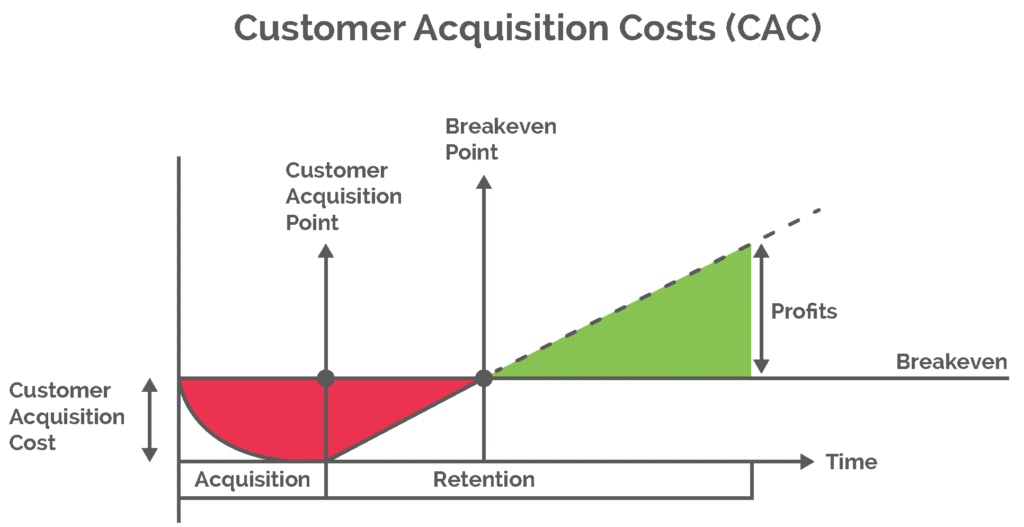Are you overly focused on landing new customers? Most companies are. But until you master keeping those customers engaged, you might as well be pouring expensive champagne down the drain without a stopper.
Selling to new customers without engaging them puts your business at risk because the costs to acquire customers quickly eat into profits. Ultimately, succeeding in business isn’t just about getting new customers; it’s about keeping the ones you already have.
In this article, I’m going to share the six pillars of successful customer retention.
Let’s dive in!
Acquiring new customers is expensive. Really expensive
Even though you rejoice for every new customer you sign, those same customers might depart before you can make a profit. In a subscription economy, converting prospects into customers doesn’t mean you’re rolling in cash immediately. That’s because acquiring new customers is incredibly expensive.
Your customer acquisition costs (CAC)—the tally of costs a business incurs to acquire new customers—include the fully-loaded sales and marketing costs required to attract potential customers and convince them to purchase.
What does your own CAC look like? To get a rough idea, add up:
- Your expenses in sales and marketing
- Employee salaries
- The costs of your sales and marketing campaigns
- Publishing and production expenses
- Paid sales commissions
- Prospect perks, like fancy dinners and golf outings
Then divide this figure by the number of newly acquired customers. The resulting figure is significant, isn’t it? For most companies, it costs up to nine times more to acquire a new customer than to keep an existing one.
Worse, it takes companies time to break even. The figure below illustrates the time it takes to reach the breakeven point after acquiring a new customer. The significance of CAC is that it takes one, two, or even three renewals to make a profit on that new modern logo your company worked so hard to sign. So, when you acquire a customer, and they churn in the first year, everyone loses.

How to avoid churn and create customers for life
Rather than pouring your investments in new customers down the drain, leverage these six pillars of successful customer retention to create customers for life.
Customer Retention Pillar #1: Front-load customer relationships
Poor onboarding and poor customer service are estimated to contribute to more than half of customer churn. In fact, avoidable customer churn costs businesses over $136 billion a year in the United States alone.
While it’s easy to blame this on lackluster products, the main reason customers leave your company is that they didn’t see value in your product in the first place. They failed to launch. This is why it is crucial to building your relationship with your customers during the onboarding process.
Onboarding is the process or action by which you familiarize your customers with your products and services. This is also the perfect time to make a difference with your product by using it to achieve success. Onboarding happens before the deal is closed and could last a few days or months, depending on the product or service.
It often includes:
- Sales and marketing materials that outline your product features and customer success services
- Scheduled handoffs to ensure internal teams are ready for the customer journey and customer teams are ready to partner with you
- Email and video how-to series to guide customers and drive product usage
You can complete an effective onboarding process in 90 seconds or 90 weeks, but it is imperative if you want to establish a lasting relationship with your new customers.
Customer Retention Pillar #2: Show the path to success
Instead of overwhelming your new customers with too much information after the sale, sell the value of your customer-facing services throughout the buyer journey. The sooner you prove to customers that you know what you’re doing and have done this before, the faster you’ll establish trust, and the simpler it’ll be to engage new customers.

The best companies in the world take the customer experience offered after the sale and infuse it into marketing and sales, so the customer gets a flavor of the good things to come. This not only incentivizes prospects to sign on the dotted line but also properly sets the expectations for what will happen after the sale.
Joey Colema, Customer Experience Expert
Showing off your onboarding and onboarding programs can even increase your deal closing rates. Hear what the CFO of a company I spoke with once told me about his experience as a buyer. During the sales cycle, when a potential vendor shared their onboarding and customer success framework, he said, “This company has their act together.” I want to work with them.”
Customer Retention Pillar #3: Align customer-facing teams
It is frustrating for customers to share similar information with the pre-sales team, the onboarding team, the customer success team, and the support team.
One of the things that customers hate more than anything else is having to answer the same question after the sales deal is done, a question they answered two to three times during the sales process.
Lincoln Murphy, customer success expert
Consulting giant McKinsey & Company discovered that prescriptive and proactive customer journeys correlate significantly more with desirable outcomes than ad hoc touchpoints. This means it’s your responsibility to bring together customer-facing teams and provide customers with collaborative and proactive best practices that drive specific results.
By aligning your teams and strategy, you create a win-win for everyone, including higher customer and employee satisfaction, increased revenue, cost improvements, and an enduring advantage over your competitors.
-
What Is B2B Retargeting and How Can It Generate More Leads?
Read more: What Is B2B Retargeting and How Can It Generate More Leads?Have you ever casually browsed a product online, only to suddenly see ads and promotions…
Customer Retention Pillar #4: Invest in user adoption
While you celebrate the official launch of a new account, user adoption just began. Your users are the people who use your product to do their job. They may be end-users, analysts, business users, administrators, or developers. It may be that they use your product every day, all day every day, or just once a year. Without user adoption, your product will likely become shelf-ware, and you’re unlikely to have a license to renew.
Consider the difference between onboarding a new account versus onboarding the people who use your software. Onboarding a new account includes one-off events like customizing and branding your product, integrating it with other systems, and setting a go-live date. Onboarding users is a whole different ballgame.
A common mistake when onboarding users is to focus on your software. I see this instinct at most companies; it’s only natural to want to explain how to navigate around your gorgeous user interface and point out all the cool features and things users can do.
However, according to customer education leader Adam Avramescu, customers don’t care about your product. Users simply want to be better at their jobs, regardless of what features and functionalities your team and you might be excited about. Providing a tour of your interface is just the tip of the iceberg of customer enablement. Your job is to make them stars in their own companies, not to make them master button clickers in your software.
That’s why it’s essential to define the unique needs of each user type. Once you determine your user roles, the next step is to understand the jobs each role “hires” your product to do and help each role do those jobs better.
Customer Retention Pillar #5: Guide customers to value
Just because you check the box on your initial onboarding doesn’t mean customers have received value. When you design an ongoing onboarding program, you increase product adoption, product usage, customer engagement, and, ultimately, the lifetime value of your product.
Rather than throwing everything about your product at users at once, guide users to initial value first. You do this by slowing down and emphasizing the basics.
For example, the first step in a customer’s journey might be to create a simple workflow. Once people in the account are comfortable with what they know and can successfully accomplish with your product, you can then guide them to create sophisticated workflows. In each step of your onboarding program, build on your customers’ existing experience and knowledge until they increase the intricacy of their work with your product.
Customer Retention Pillar #6: Listen to your customers
The key to moving your company and customers towards success is to listen and understand customers. Start with casual conversations. Give your customer a call. That’s all there is to it. Ask how things are going. And then listen.
Be sure to note down the important details and record them. You can use customer database software to ensure you always have detailed information to help you build strong relationships with your customers.
At a previous company, I prioritized calling one customer a week to listen to suggestions for improvement. The customers I listened to were instrumental when we innovated our customer-facing programs. Today, when I work with companies to create customers for life, I build customer interviews into the assessments I conduct and then include those findings as an impetus for innovation.

Final Thoughts on customer retention
I truly believe we make companies successful by engaging their customers and the people using their products without hesitation. This requires front-loading new customer relationships, showing customers the path to success, aligning customer-facing teams, investing in user adoption, guiding customers to value along their journey, and listening to customers to innovate.
DONNA WEBER is the world’s leading expert in customer onboarding. For more than two decades, she’s helped high-growth startups and established enterprises create customers for life. Her new book is Onboarding Matters: How Successful Companies Transform New Customers Into Loyal Champions. Learn more at donnaweber.com.



